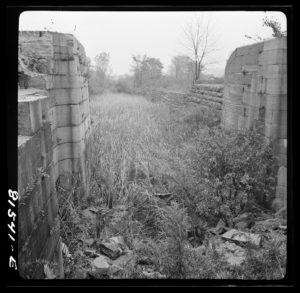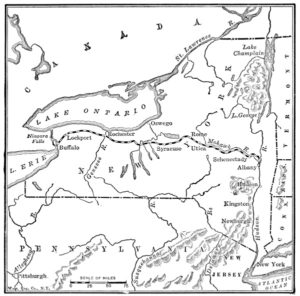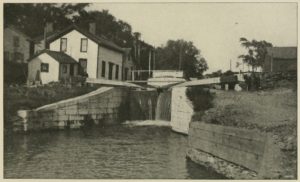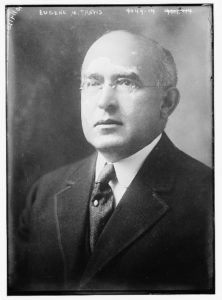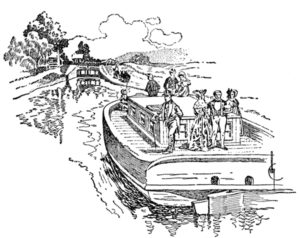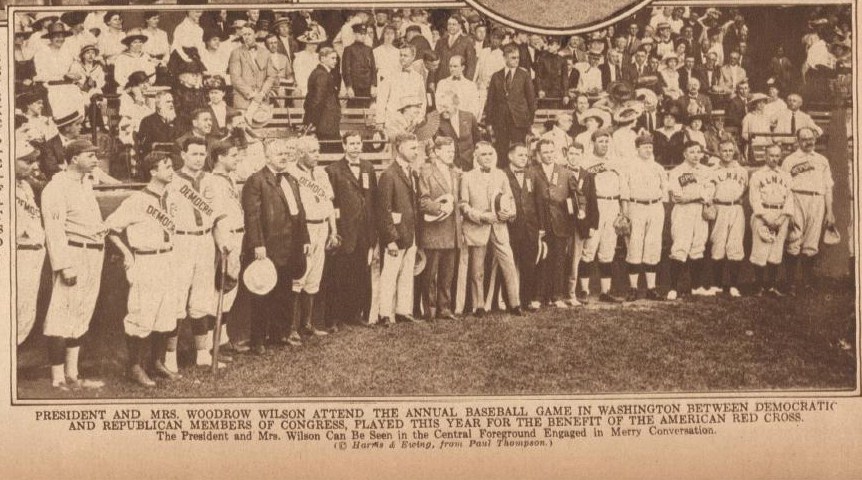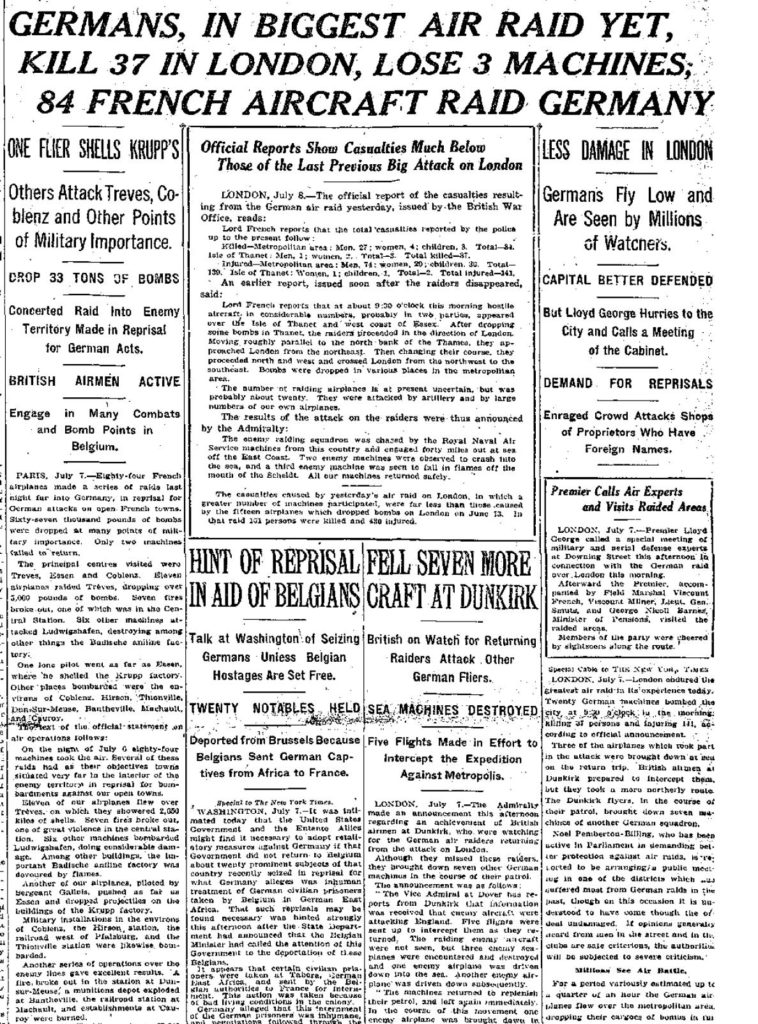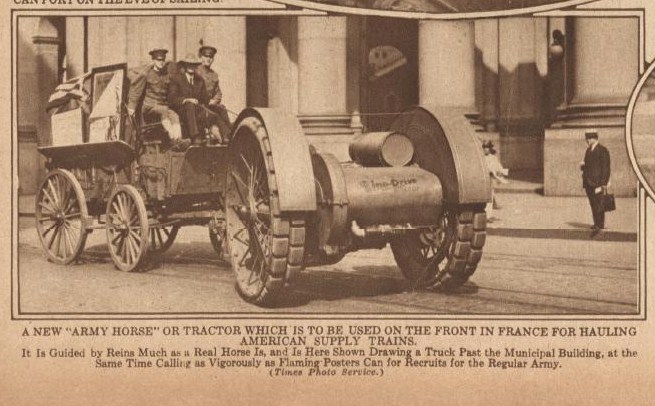I’ve lived near canals and/or old defunct canals almost all my life, so I’m a little disappointed that I forgot to mention the 200th anniversary of work beginning on the Erie Canal back on July 4th. On the bright side I’ve had more time to look through old stuff. Unfortunately we don’t have any exciting photographs of the commencement ceremony in Rome, New York back in 1817, so here’s a brief word picture. From Historic Highways of America (Vol. 14), by Archer Butler Hulbert (1904; pages 118-119) (at Project Gutenberg:
The authorities of Rome arranged with the canal commissioners to unite the celebrations of the opening of the canal with the annual Fourth of July holiday. “At the appointed time and place, Judge Hathaway, President of the village, made a short address, adapted to the occasion, and then delivered the spade into the hands of the Commissioners. After a short but graphic speech by the Commissioner Young, he handed the spade to Judge Richardson, the first contractor, who then thrust it into the ground and made the first excavation for the construction of the canal. The example was immediately followed by his own laborers, and by the assembled citizens, all ambitious of the honor of participating in the labors of that memorable occasion. Thus amid the roar of artillery, and the acclamations of the people, was begun that great work which has spread civilization, wealth and refinement….”
I guess I shouldn’t feel too bad about missing the big anniversary. There were a lot of good seaports on the American Atlantic coast two hundred years ago, but the Erie Canal gave New York City a big commercial advantage as it joined the seaboard to the land west of the Appalachians. However, back in 1917 a New York City newspaper only mentioned the centenary of the initial, ceremonial spadework as it related to war preparedness. Work on the latest canal improvement was given more of a sense of urgency because the United States had entered the Great War.
From The New-York Times July 8, 1917:
BARGE CANAL RUSHED
AS A WAR MEASURE
July 4, 1918, Date Set for Completion,
but Military Value of Waterway
Results in Intensive Operations
Along Last 15-Mile Section.
Last Wednesday, July 4, was the one hundredth anniversary of the building of the Erie Canal, which first opened for development the canal system in this country. It was not built for war use, but July 4, 1918, the date at present set for the opening of the New York State Barge Canal, which embraces the Erie and other waterways, will provide the United states with an additional route for shipments of military supplies from the Great Lakes to the Port of New York. Hope has been expressed that the Barge Canal can be opened sooner, and reinforcements of workers have been assisting the State Engineer’s office in the excavation of the final fifteen miles, or the last section of the waterway.
Congestion on the railroads will be materially decreased by the opening of the canal, and State officials have been expecting that, with the perfecting of the towboat, the round trip from the Great Lakes to New York will be made in less time than ever before, thus making the canal a war asset of no mean importance. For the public benefit, it will lower freight rates as the larger boats will make possible greater speed in delivery. …
[State Controller Eugene M. Travis extolled the new Barge Canal and explained some of the Erie’s history]: “George Washington first saw the future of canal communication, and it was at his suggestion that a survey of the route was made in 1808, although as early as 1785 he advocated the building of a waterway. Consequently, when the Canal Fund was first set aside for that purpose a century ago the venture was not considered a new nor untried one. It was not until after the War of 1812, however, when De Witt Clinton became Governor, that the digging of the famous ditch was actually begun. On April 17, 1817, the first law was enacted which provided for the connecting of the Hudson River and Lake Erie. Under its provisions five Canal Commissioners, consisting of all State officers save the Governor, were authorized to borrow money to carry on the project.
“The law also provided for the creation of a Canal Fund which was to be raised from a tax of 12½ cents per bushel on salt manufactured within the State, duties on goods sold at auction, a tax on steamboat passengers, toll from the canal, grants and donations, and a tax on real estate located within twenty-five miles of the proposed route of the canal. The work of construction, according to a marble tablet erected in honor of the event and preserved in the State Controller’s office, was begun on July 4, 1817, and as soon as each section was completed it was opened for traffic.
“On October 26, 1825, the entire 362 miles were finished at an aggregate cost of nearly $8,000,000, but within ten years after, the canal was found to be insufficient in size to accommodate the increasing volume of traffic. An act providing for its enlargement and the construction of a double set of lift locks was adopted, but twenty-seven years elapsed before this improvement, costing $31.000,000, was completed. …
“The third and greatest epoch in the canal’s history occurred within the last 30 years, when the question of a cheaper transportation was provoked by the immense traffic between the Western States and the Atlantic coast, making the Erie Canal a waterway of national importance. Then it became apparent that a barge canal was essential. The National Government had already deepened the channels of the Great lakes and the Hudson River from 12 to 20 feet, leaving the canal at its 7 foot depth. Following years of investigation the barge canal act was passed … [the work has been expensive, but throughout its history the canal always delivered a profit to the state] …
During the coming months, when the military emergencies command the complete use of every facility for the transportation of war munitions, this enlarged canal will demonstrate itself to be a commercial waterway the equal of any in the world.”
I checked. Since George Washington died in 1799, I’m not sure exactly what Controller Travis meant when he said, “and it was at his suggestion that a survey of the route was made in 1808,” but George Washington was interested in canals to as a way to connect seaboard with the continent’s interior. He was the first president of the Patowmack Company, founded in 1785, that improved the navigability of the Potomac River but was unable to build a canal through the Appalachians to link up eventually with the Ohio River valley. The Appalachian Mountains were a big obstacle in the way of east-west commerce – except in New York State where the Mohawk River flowed through a gap in the mountain range and then conveniently joined the Hudson River and its water path straight south to New York City and the ocean. George Washington realized this:
But in late 1783, awaiting the formal British surrender, he toured New York’s upstate waterways and recognized – with prescience and resignation – that they, and not Virginia’s, might prove better suited to opening the west: “Prompted by these actual observations, I could not help taking a more contemplative and extensive view of the vast inland navigation of these United States, from maps and the information of others.” The father of the nation was “struck with the immense difficulty and importance of it; and with the goodness of that Providence which has dealt her favors to us with so profuse a hand.”[1]
_________________________________
_________________________________
Looking at more news from 100 years ago, the Congressional Baseball Game does indeed have a long history:
The Red Cross seems like a pretty good choice for a charity:
In his description of the commencement ceremony at Rome Mr. Hulbert references M. S. Hawley, Origin of the Erie Canal. Jesse Hawley was one of the first proponents of a canal from the Hudson to Lake Erie. The image of the lock at Rome is from Archer Hulbert’s book.
From the Library of Congress: Old Erie canal lock at Fort Hunter; Mr. Travis; baseball image 6; army horse image 5. The map and canal boat can be found at U.S. History Images
- [1]Koeppel, Gerard. Bond of Union: Building the Erie Canal and the American Empire. Cambridge, MA: Da Capo Press, 2009. Print. page 23.↩

